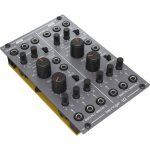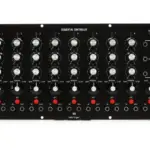behringer 182 Sequencer Legendary Analog Sequencer Module for Eurorack

Specifications
- Product Name: 182 Sequencer
- Type: Analog Sequencer Module for Eurorack
- Version: 2.0
Safety Instruction
- Please read and follow all instructions.
- Keep the apparatus away from water, except for outdoor products..
- Clean only with a dry cloth.
- Do not block any ventilation openings. Install in accordance with the manufacturer’s instructions.
- Do not install near any heat sources such as radiators, heat registers, stoves or other apparatus (including amplifiers) that produce heat.
- Use only attachments/accessories specified by the manufacturer.
- Use only specified carts, stands, tripods, brackets, or tables.
Use caution to prevent tip-over when moving the cart/apparatus combination. - Avoid installing in confined spaces like bookcases.
- Do not place near naked flame sources, such as lighted candles.
- Operating temperature range 5° to 45°C (41° to 113°F).
LEGAL DISCLAIMER
Music Tribe accepts no liability for any loss which may be suffered by any person who relies either wholly or in part upon any description, photograph, or statement contained herein. Technical specifications, appearances and other information are subject to change without notice. All trademarks are the property of their respective owners. Midas, Klark Teknik, Lab Gruppen, Lake, Tannoy, Turbosound, TC Electronic, TC Helicon, Behringer, Bugera, Aston Microphones and Coolaudio are trademarks or registered trademarks of Music Tribe Global Brands Ltd. © Music Tribe Global Brands Ltd. 2024 All rights reserved.
LIMITED WARRANTY
For the applicable warranty terms and conditions and additional information regarding Music Tribe’s Limited Warranty, please see complete details online at community. musictribe.com/support.
SEQUENCER Controls

Controls
- CH-1/CH-2 SEQUENCER COLUMNS – Use the knobs to set the control voltage output for each step. Each column sends out control voltages over a dedicated output jack (CV OUT-1 and CV OUT-2). In PARALLEL mode, two independent voltages can be set for each step for a total of up to 8 steps. In SERIES mode, you can program sequences of up to 16 steps.
- TEMPO – This knob controls the step speed of the sequencer. The internal tempo clock can also be controlled via the TEMPO CV IN jack. You can also route control voltages from the CV OUT-1 or CV OUT-2 output jacks back into the clock via the TEMPO CV IN jack to program variable timing between each step.
- DELAY – Use this knob to set the amount of time taken (0 to 10 seconds) to shift to the sequence’s next step voltage, which is set by the 16 knobs in the CH-1/CH-2 SEQUENCER COLUMNS. The DELAY parameter creates an effect similar to a portamento effect, except with an exponential response. The DELAY function only operates on the CV OUT-1 output jack (in both PARALLEL and SERIES modes). The CV OUT-2 output jack is unaffected by the DELAY control.
- GATE TIME – This knob controls the length of time the GATE OUT control voltage is active – known as the “duty cycle” – in a range from 10% to 90%.
- STEP NUMBER – Rotate this knob to set the number of steps counted before the sequencer re-starts. In PARALLEL mode, the STEP NUMBER setting affects both columns simultaneously. In SERIES mode, the STEP NUMBER setting affects only the CH-2 row so that you may create longer sequences of 9 to 16 steps.
- STEP (REPEAT/SINGLE) – This sliding switch determines how the sequencer responds to triggering. In the REPEAT setting, the sequence repeats every time it reaches the end. The SINGLE setting stops the sequence after one full cycle. The middle STEP setting advances the sequence one step each time a trigger control voltage is received a the TRIG IN jack.
- START/STOP – Press this button to trigger or stop the sequence.
- PARALLEL/SERIES – This sliding switching determines whether each step of the CH-1 and CH-2 columns trigger separately and simultaneously (PARALLEL) for sequences of up 8 steps, or if the two columns trigger one after the other (SERIES) with the CH-1 column triggering first, followed by the CH-2 column. In SERIES mode, you can create sequences of 8 to 16 steps.
- CV OUT-1/CV OUT-2 – These jacks send out separate control voltage signals for the CH-1 (CV OUT-1 jack) and CH-2 (CV OUT-2 jack) columns. When in SERIES mode, CV OUT-1 provides the 16-step output and the CV OUT-2 jack provides an 8-step output.
- TEMPO CV IN – This jack routes in a control voltage signal to control the tempo clock.
- GATE OUT – This jack sends out a gate trigger signal for every sequencer step via cables with 3.5 mm connectors.
- TRIG IN – This input allows you to route in a trigger voltage via cables with 3.5 mm connectors.
- TRIG OUT – Use this jack to send out a trigger voltage signal for use with other modules. This trigger voltage is generated when the sequencer reaches its end step.
Power Connection

The 182 SEQUENCER module comes with the required power cable for connecting to a standard Eurorack power supply system. Follow these steps to connect power to the module. It is easier to make these connections before the module has been mounted into a rack case.
- Turn the power supply or rack case power off and disconnect the power cable.
- Insert the 16-pin connector on the power cable into the socket on the power supply or rack case. The connector has a tab that will align with the gap in the socket, so it cannot be inserted incorrectly. If the power supply does not have a keyed socket, be sure to orient pin 1 (-12 V) with the red stripe on the cable.
- Insert the 10-pin connector into the socket on the back of the module. The connector has a tab that will align with the socket for correct orientation.
- After both ends of the power cable have been securely attached, you may mount the module in a case and turn on the power supply.
Installation
- The necessary screws are included with the module for mounting in a Eurorack case. Connect the power cable before mounting.
- Depending on the rack case, there may be a series of fixed holes spaced 2 HP apart along the length of the case, or a track that allows individual threaded plates to slide along the length of the case. The free-moving threaded plates allow precise positioning of the module, but each plate should be positioned in the approximate relation to the mounting holes in your module before attaching the screws.
- Hold the module against the Eurorack rails so that each of the mounting holes are aligned with a threaded rail or threaded plate. Attach the screws part way to start, which will allow small adjustments to the positioning while you get them all aligned. After the final position has been established, tighten the screws down.
Specifications

FCC
FEDERAL COMMUNICATIONS COMMISSION COMPLIANCE INFORMATION
Behringer
182 SEQUENCER
- Responsible Party Name: Music Tribe Commercial NV Inc.
- Address: 122 E. 42nd St.1, 8th Floor NY, NY 10168, United States
- Email Address: legal@musictribe.com
182 SEQUENCER
This equipment has been tested and found to comply with the limits for a Class B digital device, pursuant to part 15 of the FCC Rules. These limits are designed to provide reasonable protection against harmful interference in a residential installation. This equipment generates, uses and can radiate radio frequency energy and, if not installed and used in accordance with the instructions, may cause harmful interference to radio communications. However, there is no guarantee that interference will not occur in a particular installation. If this equipment does cause harmful interference to radio or television reception, which can be determined by turning the equipment off and on, the user is encouraged to try to correct the interference by one or more of the following measures:
- Reorient or relocate the receiving antenna.
- Increase the separation between the equipment and receiver.
- Connect the equipment into an outlet on a circuit different from that to which the receiver is connected.
- Consult the dealer or an experienced radio/TV technician for help.
This equipment complies with Part 15 of the FCC rules. Operation is subject to the following two conditions:
- this device may not cause harmful interference, and
- this device must accept any interference received, including interference that may cause undesired operation.
Important information:
Changes or modifications to the equipment not expressly approved by Music Tribe can void the user’s authority to use the equipment.
Hereby, Music Tribe declares that this product is in compliance with Directive 2014/30/EU, Directive 2011/65/EU and Amendment 2015/863/EU, Directive 2012/19/EU, Regulation 519/2012 REACH SVHC and Directive 1907/2006/EC.
Full text of EU DoC is available at https://community.musictribe.com/
- EU Representative: Music Tribe Brands DK A/S
- Address: Gammel Strand 44, DK-1202 København K, Denmark
- UK Representative: Music Tribe Brands UK Ltd.
- Address: 8th Floor, 20 Farringdon Street London EC4A 4AB,
United Kingdom
Correct disposal of this product: This symbol indicates that this product must not be disposed of with household waste, according to the WEEE Directive (2012/19/EU) and your national law. This product should be taken to a collection center licensed for the recycling of waste electrical and electronic equipment (EEE). The mishandling of this type of waste could have a possible negative impact on the environment and human health due to potentially hazardous substances that are generally associated with EEE. At the same time, your cooperation in the correct disposal of this product will contribute to the efficient use of natural resources. For more information about where you can take your waste equipment for recycling, please contact your local city office, or your household waste collection service.
FAQ
- Q: Can I use the 182 Sequencer with other Eurorack modules?
- A: Yes, the 182 Sequencer is designed to be compatible with other Eurorack modules for expanded functionality in your setup.
- Q: How many steps can the sequencer sequence?
- A: The sequencer can sequence up to 16 steps per sequence, providing versatility in creating complex patterns and melodies.
Documents / Resources
 |
behringer 182 Sequencer Legendary Analog Sequencer Module for Eurorack [pdf] User Guide 182 Sequencer Legendary Analog Sequencer Module for Eurorack, 182, Sequencer Legendary Analog Sequencer Module for Eurorack, Legendary Analog Sequencer Module for Eurorack, Analog Sequencer Module for Eurorack, Sequencer Module for Eurorack, Module for Eurorack, Eurorack |



